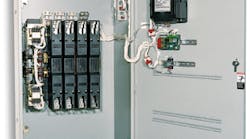If you've been putting off conducting maintenance checks, you could be doing more damage than you think.
An automatic transfer switch (ATS) is a critical part of any emergency power supply system (EPSS). The ATS is the device that selects a power source—either normal utility power or standby generator power—and conducts the power to critical loads. The NFPA, Joint Commission on Accreditation of Healthcare Organizations (JCAHO), and all major ATS manufacturers publish literature calling for the monthly test of ATSs, yet many facility owners ignore these guidelines and refuse to perform the tests. There are good reasons for both the monthly-test requirement and for the reluctance of many operators to comply.
NFPA 110, the standard for emergency and standby power supply systems, states “the monthly test of a transfer switch shall consist of electrically operating the transfer switch from the standard position to the alternate position and then a return to the standard position” (Paragraph 8.4.5.1). The standard also requires a monthly generator run. The best way to perform both these tests is by operating the test toggle on the ATS when the generator isn’t running, and confirming that the ATS properly signals the generator to start and run before transferring building load.
Reasons for ATS testing.
There are three primary reasons for the monthly test requirement. First, a test is an active demonstration that the EPSS is still able to function as intended. If a switch is going to fail to transfer, it’s better to have the switch fail while connected to a live normal source during a test than to have it remain connected to a dead normal source during an actual power outage.
Second, an automatic transfer switch is an electromechanical device with moving parts. Like the pistons and crankshaft in an automotive engine, the moving parts in an ATS can seize if they’re left in one position for months or years. Regular exercise will help ensure that moving parts will continue to operate smoothly.
Third, a transfer switch test transfers building load onto the generator for the duration of the generator test. Most standby power generators of more than 100kW are diesel engine driven, and all major diesel generator manufacturers recommend a load of at least 50% of maximum capacity during monthly generator tests. NFPA requires the same thing, for the simple reason that running under a light load is very bad for a diesel engine.
Running a diesel generator in an unloaded condition—with no ATS transfer, thus with no building load connected—causes carbon buildup in the cylinders and exhaust system, a condition known as “wet stacking.” This problem reduces efficiency and power, and in extreme cases it can cause an exhaust system to catch fire. To reduce a wet-stack condition once it has developed, some facility owners will rent a resistive load bank and connect it to the standby generator for a full-load run of sufficient duration to “burn out” the buildup. The cost for such an exercise is substantial, and the relief provided is only temporary.
Why some facility operators won’t test.
Some people mistakenly think that monthly tests will shorten the life of a transfer switch, and are therefore reluctant to conduct them. More often, the reason for refusing to test properly is a fear of the two brief interruptions in power that an ATS test entails.
There’s no truth to the idea of a regular test shortening the life of an ATS. Any device to be used as a transfer switch—switching a single electrical load between two sources of power—must comply with UL standard 1008, the only standard applicable to this duty.
Any switch that bears a UL 1008 label can transfer a minimum of 3,000 times, with at least 1,000 of those operations under at least 100% of rated load. (For smaller ampacity switches 6,000 transfers must be under 100% load or greater).
A switch that transfers back and forth each month will see 12 transfer operations per year, generally under something less than 100% of rated load. It would take a transfer switch at least 83 years to reach the same level of full-load use that representative switches endure in standard UL testing. And, as mentioned above, a switch that transfers regularly is less prone to seizure than a switch that has remained static for a long period.
The most-cited reason for failing to test transfer switches is that power interruptions can cause problems with lighting, transformers, computers, and other sensitive loads. It’s this fear, primarily, that causes many facility operators to conduct their monthly generator runs without switching building load onto the generator.
While problems of this nature can be frightening, they should be no more frightening than the prospect of a transfer switch that fails to operate at a critical time due to lack of testing, or a generator that fails due to wet-stacking. There are several ways of mitigating or eliminating the problems caused by these power interruptions, both in new construction and in existing facilities.
Solving the problem.
For new construction projects the issue of transfer-test-caused interruptions in power is an easy one to solve. The engineer responsible for specifying the electrical equipment should specify “closed transition,” or make-before-break, transfer switches. A transfer switch of this kind transfers when in its test mode, with no interruption in power. Switches of this kind were once a special product available from only one manufacturer, and they carried a daunting price premium. Today, however, closed transition transfer switches (CTTS) are available from several manufacturers, and at a very modest price premium over the old-fashioned open transition switch.
For existing facilities, a study should be done to determine which specific transfer switches feed loads that would actually suffer any negative impact from monthly interruptions in power. Those loads that are sensitive to interruptions can be protected with UPS systems, or with a timed pre-signal before transfer, allowing for orderly shutdown of the loads before power is interrupted. Also, existing open transition switches can be replaced with CTTS.
Any automatic transfer switch in an emergency or standby power system should be should be tested monthly in accordance with NFPA 110. That test should consist of an automatic generator start, initiated by the transfer switch, followed by an automatic transfer of facility load onto the standby generator. If power interruptions are a matter of concern, closed transition transfer switches should be used to eliminate the problem, or other methods should be used to mitigate the effects.
Blaine is a transfer switch product specialist for SF Griggs & Associates in Seattle.



